物流学原理简答及填空答案
(2021年整理)物流考试简答题
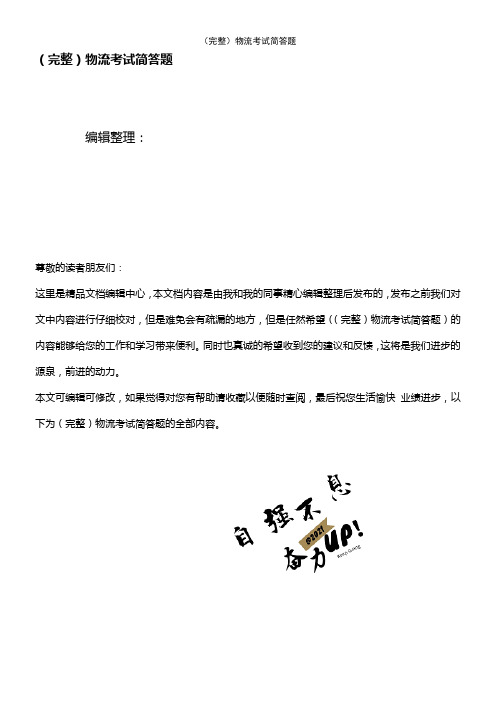
(完整)物流考试简答题编辑整理:尊敬的读者朋友们:这里是精品文档编辑中心,本文档内容是由我和我的同事精心编辑整理后发布的,发布之前我们对文中内容进行仔细校对,但是难免会有疏漏的地方,但是任然希望((完整)物流考试简答题)的内容能够给您的工作和学习带来便利。
同时也真诚的希望收到您的建议和反馈,这将是我们进步的源泉,前进的动力。
本文可编辑可修改,如果觉得对您有帮助请收藏以便随时查阅,最后祝您生活愉快业绩进步,以下为(完整)物流考试简答题的全部内容。
物流系统的特点有哪些?1、物流系统是复杂系统2、物流系统是大跨度系统3、物流系统环境稳定性差而动态性强4、物流系统属于中层次系统第三方物流的特征有哪些?1、第三方物流是合同导向的一系列服务2、第三方物流是个性化物流服务3、是建立在现代信息技术基础上的4、第三方物流企业与用户企业是联名关系供应链管理模式的采购与传统意思上采购策略的差异表现在那几个方面?1)为订单而采购,而非为库存而采购2)从一般买卖关系转向战略合作伙伴关系3)变多源供应变为少源供应4)变大批量少批次采购行为为小批量多批次采购防止无效装卸作业的手段有哪些?1)尽量减少装卸次数2)提高被装卸物料的纯度3)包装要适宜4)缩短搬运作业的距离提高顾客服务绩效的途径有哪些?彻底研究顾客的需求;在认真权衡成本与收益的基础上确定最优的顾客服务水平;在订货系统中采用最先进的技术手段;考核评价物流管理各环节的绩效物流系统评价必须遵循哪些原则?2、简述配送中心及其作用。
3、物流质量具体包含哪些内容?1总的来说,物流系统评价需要有一定的评价标准,这样才能衡量物流系统实际的运行状况。
要对各种物流系统作出客观公正的评价,就应该根据各个系统的不同情况制定出评价的标准,通常评价标准包括一下几项:(1)经济性;(2)可靠性;(3)灵活性;(4)安全性;(5)易操作性;(6)可扩展性;(7)劳动强度;(8)服务水平;(9)敏感性。
物流管理简答题整理

物流管理简答题四、简答题1物流系统的基本特征是什么?(一)物流系统的客观存在性(二)物流系统是一个大跨度系统(三)物流系统稳定性较差而动态性较强(四)物流系统属于中间层次系统范畴(五)物流系统的复杂性(六)物流系统的系统结构要素间有非常强的背反现象2举例说明物流系统中的“二律背反”现象。
物流的各项活动(运输、保管、搬运、包装、流通加工)之间存在”效益背反”(Trad off),所谓"效益背反”是指"对于同一资源(例如成本)的两个方面处于相互矛盾的关系之中,想要较多地达到其中一个方面的目的,必然使另一方面的目的受到部分损失".(1)减少库存据点并尽量减少库存,势必使库存补充变得频繁,必然增加运输次数。
简化包装,则包装强度降低,仓库里的货物就不能堆放过高,这就降低了保管效率。
而且在装卸和运输过程中容易出现破损,以致搬运效率下降,破损率增多。
(2)将铁路运输改为航空运输,虽然运费增加了,而运输速度却大幅度提高了.不但减少了各地物流据点的库存,还大量减少了仓储费用。
(3)由于各物流活动之间存在着”效益背反”,因而就必须研究总体效益,使物流系统化。
3简述物流规划的层次。
国家一级的物流规划、盛世一级的物流规划、经济运行部门的物流规划、企业物流规划、科技、教育、大型物流企业培训和发展规划4什么是精益物流战略?精益物流战略的目标是用较少的资源,如人力、空间、设备、时间来进行各种操作,有效组织物料的流动,杜绝浪费,使用最短的前置期,使库存和成本最小化。
精益战略寻找出消除浪费的途径,典型的方法是对目前的操作进行详细分析,然后取消不增加价值的操作,消除耽搁,简化过程,降低复杂性,提高效率,寻找规模经济,节省运输费用,除去供应链中不必要的环节5JIT采购的主要特点。
1、采用较少的供应商2、采取小批量采购的策略3、对供应商选择的标准发生变化4、对交货的准时性要求更加严格5、从根源上保障采购质量6、对信息交流的需求加强7、可靠的送货和特定的包装要求6什么是成组运输技术?采用一定的办法,把分散的单件货物组合在一起,成为一个规格化、标准化的大运输单位进行运输.成组运输中主要用到托盘技术和集装系技术.7什么叫多式联运?是在集装箱运输的基础上产生发展起来的现代运输方式。
物流管理简答题整理
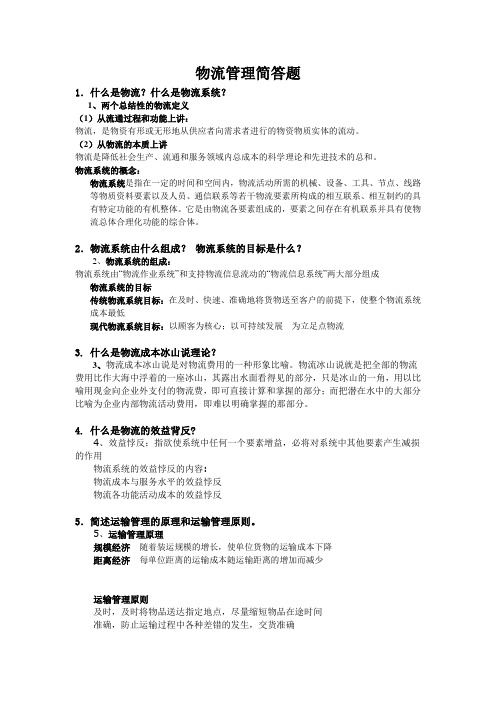
物流管理简答题1.什么是物流?什么是物流系统?1、两个总结性的物流定义(1)从流通过程和功能上讲:物流,是物资有形或无形地从供应者向需求者进行的物资物质实体的流动。
(2)从物流的本质上讲物流是降低社会生产、流通和服务领域内总成本的科学理论和先进技术的总和。
物流系统的概念:物流系统是指在一定的时间和空间内,物流活动所需的机械、设备、工具、节点、线路等物质资料要素以及人员、通信联系等若干物流要素所构成的相互联系、相互制约的具有特定功能的有机整体。
它是由物流各要素组成的,要素之间存在有机联系并具有使物流总体合理化功能的综合体。
2.物流系统由什么组成?物流系统的目标是什么?2、物流系统的组成:物流系统由“物流作业系统”和支持物流信息流动的“物流信息系统”两大部分组成物流系统的目标传统物流系统目标:在及时、快速、准确地将货物送至客户的前提下,使整个物流系统成本最低现代物流系统目标:以顾客为核心;以可持续发展为立足点物流3. 什么是物流成本冰山说理论?3、物流成本冰山说是对物流费用的一种形象比喻。
物流冰山说就是把全部的物流费用比作大海中浮着的一座冰山,其露出水面看得见的部分,只是冰山的一角,用以比喻用现金向企业外支付的物流费,即可直接计算和掌握的部分;而把潜在水中的大部分比喻为企业内部物流活动费用,即难以明确掌握的那部分。
4. 什么是物流的效益背反?4、效益悖反:指欲使系统中任何一个要素增益,必将对系统中其他要素产生减损的作用物流系统的效益悖反的内容:物流成本与服务水平的效益悖反物流各功能活动成本的效益悖反5.简述运输管理的原理和运输管理原则。
5、运输管理原理规模经济随着装运规模的增长,使单位货物的运输成本下降距离经济每单位距离的运输成本随运输距离的增加而减少运输管理原则及时,及时将物品送达指定地点,尽量缩短物品在途时间准确,防止运输过程中各种差错的发生,交货准确经济,选择合理运输方式和路线,有效利用各种运输工具和设备,降低费用安全,防止霉烂、残损及意外事故的发生,保证物品完整无损方便,考虑客户取送货物的便利性,办理相关手续的简便性,能够方便地对运输中的货物跟踪、查询6. 基本的运输方式通常指哪几种?在物流运作中它们各有什么特点?6、五种基本的运输方式铁路运输:铁路运输在我国运输行业中有着非常突出的作用。
《物流学》习题参考答案
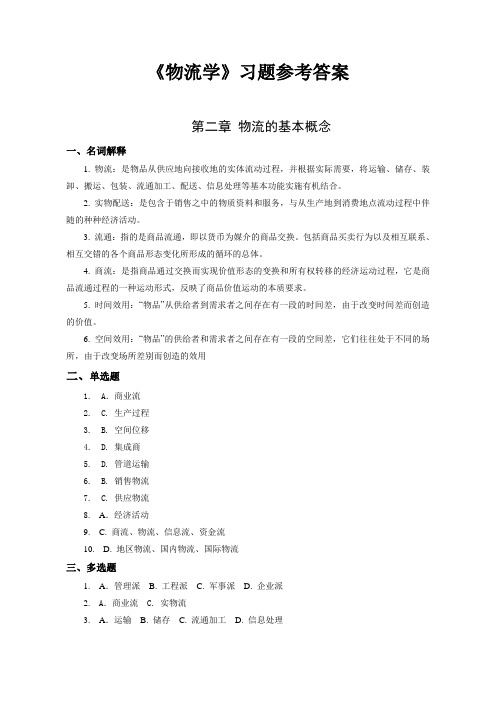
《物流学》习题参考答案第二章物流的基本概念一、名词解释1. 物流:是物品从供应地向接收地的实体流动过程,并根据实际需要,将运输、储存、装卸、搬运、包装、流通加工、配送、信息处理等基本功能实施有机结合。
2. 实物配送:是包含于销售之中的物质资料和服务,与从生产地到消费地点流动过程中伴随的种种经济活动。
3. 流通:指的是商品流通,即以货币为媒介的商品交换。
包括商品买卖行为以及相互联系、相互交错的各个商品形态变化所形成的循环的总体。
4. 商流:是指商品通过交换而实现价值形态的变换和所有权转移的经济运动过程,它是商品流通过程的一种运动形式,反映了商品价值运动的本质要求。
5. 时间效用:“物品”从供给者到需求者之间存在有一段的时间差,由于改变时间差而创造的价值。
6. 空间效用:“物品”的供给者和需求者之间存在有一段的空间差,它们往往处于不同的场所,由于改变场所差别而创造的效用二、单选题1. A.商业流2. C. 生产过程3. B. 空间位移4. D. 集成商5. D. 管道运输6. B. 销售物流7. C. 供应物流8. A.经济活动9. C. 商流、物流、信息流、资金流10. D. 地区物流、国内物流、国际物流三、多选题1. A.管理派 B. 工程派 C. 军事派 D. 企业派2. A.商业流 C. 实物流3. A.运输 B. 储存 C. 流通加工 D. 信息处理4. A.商流、物流 C.信息流、资金流5. A.国内物流 B. 国际物流 D. 地区物流6. B. 装卸搬运、包装 D. 运输、储存 E. 流通加工、信息处理四、判断题1.(正确)2.(错误)。
物流主要进行运输和储存,实现物资实体空间和时间转移,而商流过程主要进行商品交换,实现物资所有权的转移。
3.(错误)。
现代流通领域已包含有四大支柱流:商流、物流、信息流、资金流。
4.(错误)。
一项增值性物流服务一旦成为物流产业普遍实施的、标准性的服务时,它就失去了增值性服务的功用,而成为了基本的物流服务功能。
物流管理原理考试题及答案

物流管理原理考试题及答案一、选择题1. 物流是指()。
A. 物品的流动B. 物质的转移C. 货物的运输D. 物流公司的经营答案:B. 物质的转移2. 以下哪个不属于物流管理的基本要素?A. 供应链管理B. 运输管理C. 仓储管理D. 计划与控制答案:A. 供应链管理3. 物流的目标是()。
A. 实现货物的快速运输B. 提高供应链的效率C. 减少仓储成本D. 提供顾客满意的服务答案:D. 提供顾客满意的服务4. 以下哪个不属于物流成本的组成部分?A. 运输成本B. 仓储成本C. 人力资源成本D. 信息技术成本答案:C. 人力资源成本5. 物流网络设计的目的是()。
A. 降低物流成本B. 提高物流服务水平C. 优化物流运输路线D. 实现物流过程的自动化答案:B. 提高物流服务水平二、判断题1. 物流管理的核心任务是实现货物的运输和仓储。
答案:错误2. 优化供应链是物流管理的重要目标之一。
答案:正确3. 物流成本只包括运输成本和仓储成本。
答案:错误4. 物流网络设计的主要目的是降低运输成本。
答案:错误5. 物流管理可以通过信息技术实现流程的自动化。
答案:正确三、简答题1. 请简要说明物流管理的基本要素。
答案:物流管理的基本要素包括运输管理、仓储管理、库存管理、物流信息管理、物流组织与协调、客户服务等。
运输管理涉及货物的运输工具选择、运输计划制定、运输成本控制等;仓储管理包括仓库的选址、仓库设计与布局、仓储操作与管理等;库存管理旨在实现合理备货水平,包括安全库存、经济批量、订单满足率等指标的控制;物流信息管理通过信息技术实现物流数据的采集、传输、处理与分析;物流组织与协调负责物流网络的规划与设计、业务流程的优化与协调;客户服务则强调提供满足客户需求的物流服务。
2. 请简要介绍物流成本的组成部分。
答案:物流成本主要包括运输成本、仓储成本、库存成本和信息技术成本。
运输成本是指货物运输的直接成本,包括运输工具的运营费用、人工费用、燃料费用等;仓储成本主要指仓库的租金、设备维护费用、人力资源成本等;库存成本包括货物占用资金、仓储费用、货损与报废的成本等;信息技术成本是指物流信息系统的建设与维护所产生的成本,包括硬件设备、软件开发与运维费用等。
物流学课程复习资料及参考答案
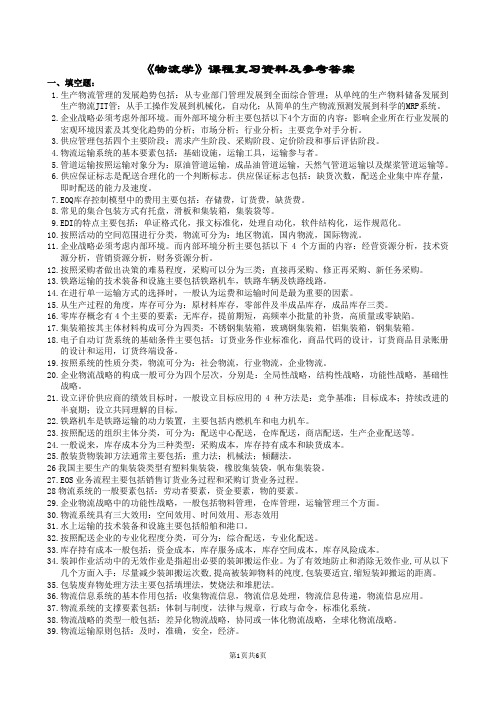
《物流学》课程复习资料及参考答案一、填空题:1.生产物流管理的发展趋势包括:从专业部门管理发展到全面综合管理;从单纯的生产物料储备发展到生产物流JIT管;从手工操作发展到机械化,自动化;从简单的生产物流预测发展到科学的MRP系统。
2.企业战略必须考虑外部环境。
而外部环境分析主要包括以下4个方面的内容:影响企业所在行业发展的宏观环境因素及其变化趋势的分析;市场分析;行业分析;主要竞争对手分析。
3.供应管理包括四个主要阶段:需求产生阶段、采购阶段、定价阶段和事后评估阶段。
4.物流运输系统的基本要素包括:基础设施,运输工具,运输参与者。
5.管道运输按照运输对象分为:原油管道运输,成品油管道运输,天然气管道运输以及煤浆管道运输等。
6.供应保证标志是配送合理化的一个判断标志。
供应保证标志包括:缺货次数,配送企业集中库存量,即时配送的能力及速度。
7.EOQ库存控制模型中的费用主要包括:存储费,订货费,缺货费。
8.常见的集合包装方式有托盘,滑板和集装箱,集装袋等。
9.EDI的特点主要包括:单证格式化,报文标准化,处理自动化,软件结构化,运作规范化。
10.按照活动的空间范围进行分类,物流可分为:地区物流,国内物流,国际物流。
11.企业战略必须考虑内部环境。
而内部环境分析主要包括以下4个方面的内容:经营资源分析,技术资源分析,营销资源分析,财务资源分析。
12.按照采购者做出决策的难易程度,采购可以分为三类:直接再采购、修正再采购、新任务采购。
13.铁路运输的技术装备和设施主要包括铁路机车,铁路车辆及铁路线路。
14.在进行单一运输方式的选择时,一般认为运费和运输时间是最为重要的因素。
15.从生产过程的角度,库存可分为:原材料库存,零部件及半成品库存,成品库存三类。
16.零库存概念有4个主要的要素:无库存,提前期短,高频率小批量的补货,高质量或零缺陷。
17.集装箱按其主体材料构成可分为四类:不锈钢集装箱,玻璃钢集装箱,铝集装箱,钢集装箱。
物流学试题及答案考研

物流学试题及答案考研一、单项选择题(每题2分,共20分)1. 物流学中的“第三利润源”指的是()。
A. 原材料成本降低B. 劳动力成本降低C. 物流成本降低D. 销售成本降低2. 在物流网络中,节点主要承担的是()。
A. 存储功能B. 运输功能C. 信息处理功能D. 以上都是3. 物流信息系统中,EDI代表的是()。
A. 电子数据交换B. 电子文档接口C. 企业资源规划D. 企业分销管理4. 以下哪项不是物流服务的特点?()A. 可存储性B. 可分割性C. 可替代性D. 无形性5. 第三方物流(3PL)提供的服务不包括()。
A. 运输服务B. 仓储服务C. 金融服务D. 生产制造二、多项选择题(每题3分,共15分)6. 物流成本包括以下哪些方面?()A. 运输成本B. 仓储成本C. 包装成本D. 客户服务成本7. 物流网络的设计需要考虑的因素包括()。
A. 地理位置B. 市场需求C. 运输成本D. 竞争对手的网络布局8. 以下哪些属于物流风险管理的内容?()A. 货物损失风险B. 运输途中风险C. 信用风险D. 市场风险9. 物流服务水平的提升可以通过以下哪些方式实现?()A. 提高运输效率B. 增加库存量C. 优化配送路线D. 提高信息技术水平10. 物流信息技术的应用可以带来哪些好处?()A. 提高物流效率B. 降低物流成本C. 提升客户满意度D. 增强市场竞争力三、简答题(每题10分,共20分)11. 简述物流系统的基本功能。
答:物流系统的基本功能包括运输、存储、包装、装卸搬运、流通加工、物流信息处理和客户服务。
12. 描述供应链管理中的牛鞭效应及其成因。
答:牛鞭效应是指在供应链中,由于信息的不对称和预测的不准确,导致上游供应商面对的需求波动大于下游客户的实际需求波动。
成因包括需求预测的误差放大、库存策略的非理性、价格波动和促销活动等。
四、计算题(每题15分,共30分)13. 某物流公司承接了一项运输任务,运输成本由固定成本和变动成本组成。
物流学简答题

1.试述运送业有别于其他行业旳特点。
答: ①运送具有生产旳本质属性;②运送服务旳公共性;③运送产品是无形产品;④运送生产与运送消费同步进行;⑤运送产品具有非储存性;⑥运送产品旳同一性。
2.试述减少运送成本旳途径。
答: ①选择合理旳运送工具;②减少装卸搬运成本;③拥有合适旳运送工具;④优化运送路线;⑤优化运送方式;⑥优化仓库布局;⑦开展集运方式。
3.简述物流与运送旳关系答: 运送是指物品借助于运力在空间上产生旳位置移动;而物流是根据实际需要, 通过将运送等基本功能实行有机结合, 实现物品从供应地到接受地旳实体流动过程。
因此, 物流旳含义远超过了运送含义, 运送只是物流过程中旳重要环节。
4.商业内部物流涉及哪些内容?答: 涉及商业批发业与零售业所组织旳物流运动。
5.简述物流职能旳内容答: ①运送职能②保管职能③流通加工职能④配送旳职能⑤信息职能6.试析物流在国民经济中旳作用答: ①物流在国民经济增长中起到了基础性支撑作用。
②在国民经济和地区经济中可以发挥带动作用和支持整个国民经济旳作用。
③可以成为国家或地区财政收入旳重要来源和发明就业领域。
④能成为现代科技旳应用领域。
7.商流与物流旳关系答: 一般来讲, 商流和物流是前后继起旳运动。
在商品经济旳条件下, 商流是物流旳前提, 而物流是商流旳继续和完毕。
只有通过商流, 才干实现产品所有权、支配权、使用权旳转移;而在商流旳基础上必须通过物流才干实现产品由生产领域向消费领域旳运动。
因此, 物流要受商流旳制约, 而商流要靠物流来完毕。
8.什么是物流运送?论述运送在物流中旳地位。
答:物流运送:用设备和工具, 将物品从一地点向另一地点运送旳物流活动。
地位:①运送是物流活动旳核心②运送影响着物流旳其他构成因素③合理运送是减少物流费用旳核心。
9.水路运送方式旳优缺陷是什么?答: 长处: ①运送能力大②在运送条件良好旳船道, 船舶旳通过能力几乎不受限制。
③运送旳通用性能不错, 可运送多种货品④成本低⑤续航能力大。
物流学原理复习题

《物流学原理》复习题一、名词解释1、物流2、装卸搬运3、物流系统4、生产物流5、物流标准化6、国际物流系统网络7、物流技术二、简答题1、简述物流的效用。
2、包装合理化的途径主要有哪些?3、简述物流系统化的5S目标。
4、简述影响生产物流的主要因素。
5、简述使用第三方物流的优越性。
6、简述保税仓库的几种类型。
7、简述物流技术装备配置的基本原则。
三、计算题某公司每年需要采购零件1,000只,单价为10元,每次订货成本为8元,单位储存成本为单价的16%,求该零件的经济订购批量,并求订购次数和订货间隔期和库存总成本。
(一年按360天计)四、案例分析题日本世界物流中心株式会社成立于1991年4月,资本额24亿日元,占地92870平方米,地下一层,地上5层。
该中心配有载货电梯23台,垂直输送机46台,油压升降平台149台,垂直升降平台23台。
进出货月台只设在一楼的前后,货物的上下是利用电梯和垂直输送机的搬运方式,而不是采用卡车上下各楼层的方式。
该物流中心的主要功能是处理商品的进出货、装卸、捡货、配送、流通加工、储存保管、库存管理、品质管理等,是一大型综合物流中心。
世界物流中心位于东京港,联接大型货柜场站群(大井货柜场及青海货柜场),是世界主要港口及货柜商船的主要航路。
中心离著名的成田机场只有70km,从中心到首都高速公路只要数分钟,到东京市中心只要10min就可以到达。
世界物流中心在几分钟内可以到达弯岸道路,同时与日本全国高速公路网连接,且接近铁路货运站。
世界物流中心连接的腹地——东京都圈,是世界最大规模的经济活动地区,在100km 半径内有日本人口的四分之一,约3000万人在此生活,是世界最大的消费地区。
问题:(1)哪些因素影响了世界物流中心的选址?(2)从世界物流中心的内部结构和其腹地的特点看,该中心主要从事哪类商品的流转?为什么?。
(完整版)物流学试题及答案

一、简答题(每题2分,共20分)1、物流的思想最初源于哪个国家?美国2、物流系统的主要目标是什么?降低物流系统的成本、提高客户服务水平、环境保护。
3、最重要的物流活动有哪些?运输、仓储。
4、企业中的物品储存有哪些弊病?保管费的支出、库存商品的损坏、经济贬值、流动资金的占用。
5、哪种运输工具能够提供最好的“门到门”服务?汽车6、零库存管理的基本思想是什么?货物恰好在需要的时刻到达7、生产包装与流通包装有什么不同?前者侧重商品的理化性质的保护和外型的保护,后者侧重商品的储运方便。
8、什么是货物的搬运活性指数?货物从静止状态转变为运动状态的难易程度。
9、什么是第三方物流?除商品的供给方和需求方以外的物流服务提供者。
10、什么是物流供应链?在生产与流通过程中,从原材料的供应、半成品或零部件的制造、产品的生产、批发、零售,直到商品到达消费者手中的全过程。
二、多项选择题(每题2分,共30分)1、以下哪种活动不是物流活动?A: 储存 B: 送货 C: 销售 D 上门安装2、以下哪种器具属于集装器具?A 木箱B 铁桶C滑板 D 托盘3、哪一种包装材料可以自然降解?A 玻璃纸B 稻草C 塑料D 藤条4、哪一种类型的企业不可能直接从事物流服务?A 生产企业B 第三方物流企业C 第四方物流企业D 零售商店5、以下四个英文名词中,不是“物流”的英译的词是:A Material flowB Physical distributionC Logistics D Material current6、为了降低物流成本,仓库:A 进货速度越快越好B 应该保持足够多的库存;C 不能有任何缺货;D 使货物通过的速度越快越好。
7、流通加工是:A 生产加工的补充与完善B 残次品的返工 C回收旧货的改造 D 满足客户个性化需求的商品再加工。
8、库存货物的定货点是:A 定货时间B 定货地点C 剩余库存量水平D 仓库内货物的存放地点9、安全库存量是:A 防止货物剩余积压的最大数量限制B 防止货物对仓库货架造成危害对货物数量的限制C 防止由于意外的过量出货可能造成缺货而多存储的货物D 防止由于仓库进货不及时可能造成的缺货而多储存的备货10、条码在物流中的作用是:A 车辆定位B 货物名称识别C 防伪标志D 所属货主的识别11、从物流角度分析,软饮料的包装容器不宜采用:A 玻璃瓶B 铝合金罐C 复合纸盒D 塑料瓶12、GPS在物流中的应用主要是:A 货物的动态跟踪B 物流成本控制C 客户订货确认D 运输工具的导向13、城市物流配送“门到门”运输的主要工具有:A 大型集装箱拖车B 小型封闭式货车C 高速轻轨D 非机动车辆14、商流包括:A 商品的空间位置流动B 商品的销售结算C 商品的广告宣传 D 签订买卖合同。
《物流学》习题及参考答案
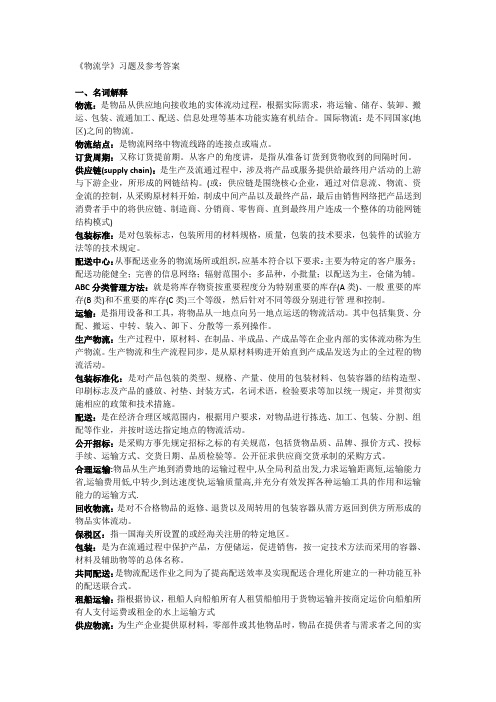
《物流学》习题及参考答案一、名词解释物流:是物品从供应地向接收地的实体流动过程,根据实际需求,将运输、储存、装卸、搬运、包装、流通加工、配送、信息处理等基本功能实施有机结合。
国际物流:是不同国家(地区)之间的物流。
物流结点:是物流网络中物流线路的连接点或端点。
订货周期:又称订货提前期。
从客户的角度讲,是指从准备订货到货物收到的间隔时间。
供应链(supply chain):是生产及流通过程中,涉及将产品或服务提供给最终用户活动的上游与下游企业,所形成的网链结构。
(或:供应链是围绕核心企业,通过对信息流、物流、资金流的控制,从采购原材料开始,制成中间产品以及最终产品,最后由销售网络把产品送到消费者手中的将供应链、制造商、分销商、零售商、直到最终用户连成一个整体的功能网链结构模式)包装标准:是对包装标志,包装所用的材料规格,质量,包装的技术要求,包装件的试验方法等的技术规定。
配送中心:从事配送业务的物流场所或组织,应基本符合以下要求:主要为特定的客户服务;配送功能健全;完善的信息网络;辐射范围小;多品种,小批量;以配送为主,仓储为辅。
ABC分类管理方法:就是将库存物资按重要程度分为特别重要的库存(A类)、一般重要的库存(B类)和不重要的库存(C类)三个等级,然后针对不同等级分别进行管理和控制。
运输:是指用设备和工具,将物品从一地点向另一地点运送的物流活动。
其中包括集货、分配、搬运、中转、装入、卸下、分散等一系列操作。
生产物流:生产过程中,原材料、在制品、半成品、产成品等在企业内部的实体流动称为生产物流。
生产物流和生产流程同步,是从原材料购进开始直到产成品发送为止的全过程的物流活动。
包装标准化:是对产品包装的类型、规格、产量、使用的包装材料、包装容器的结构造型、印刷标志及产品的盛放、衬垫、封装方式,名词术语,检验要求等加以统一规定,并贯彻实施相应的政策和技术措施。
配送:是在经济合理区域范围内,根据用户要求,对物品进行拣选、加工、包装、分割、组配等作业,并按时送达指定地点的物流活动。
物流学基础试题及答案

物流学基础试题及答案一、单项选择题(每题2分,共20分)1. 物流学中,下列哪项不是物流的基本功能?A. 运输B. 仓储C. 包装D. 销售2. 物流管理的核心目标是实现以下哪项?A. 成本最小化B. 服务最优化C. 效率最大化D. 以上都是3. 在物流活动中,下列哪项不是运输方式的特点?A. 公路运输灵活性高B. 铁路运输成本较低C. 航空运输速度最快D. 水路运输成本最高4. 物流信息系统的主要功能不包括以下哪项?A. 信息收集B. 信息处理C. 信息存储D. 物理配送5. 第三方物流(3PL)提供商的作用不包括以下哪项?A. 提供运输服务B. 提供仓储服务C. 提供物流咨询D. 生产制造产品6. 物流成本控制不包括以下哪项?A. 运输成本控制B. 仓储成本控制C. 人力资源成本控制D. 销售成本控制7. 物流网络设计的主要目标不包括以下哪项?A. 提高服务水平B. 降低运输成本C. 增加库存量D. 提高运营效率8. 供应链管理中,下列哪项不是供应链的关键要素?A. 供应商B. 制造商C. 零售商D. 竞争对手9. 逆向物流与传统物流的主要区别在于以下哪项?A. 流向相反B. 服务对象不同C. 运输方式不同D. 仓储条件不同10. 物流服务水平的衡量指标不包括以下哪项?A. 订单履行率B. 准时交货率C. 库存周转率D. 产品价格二、多项选择题(每题3分,共15分)1. 物流活动中,下列哪些属于物流成本的组成部分?A. 运输成本B. 仓储成本C. 包装成本D. 广告成本2. 物流服务的要素包括以下哪些?A. 可靠性B. 响应性C. 保证性D. 个性化3. 物流网络设计需要考虑的因素包括以下哪些?A. 客户需求B. 运输成本C. 地理位置D. 政治因素4. 供应链管理中,下列哪些属于供应链的风险?A. 供应风险B. 运营风险C. 金融风险D. 信息风险5. 逆向物流的类型包括以下哪些?A. 退货物流B. 维修物流C. 回收物流D. 废弃物物流三、判断题(每题2分,共10分)1. 物流学是一门研究物品从供应地到需求地的流动过程的学科。
物流学答案 2
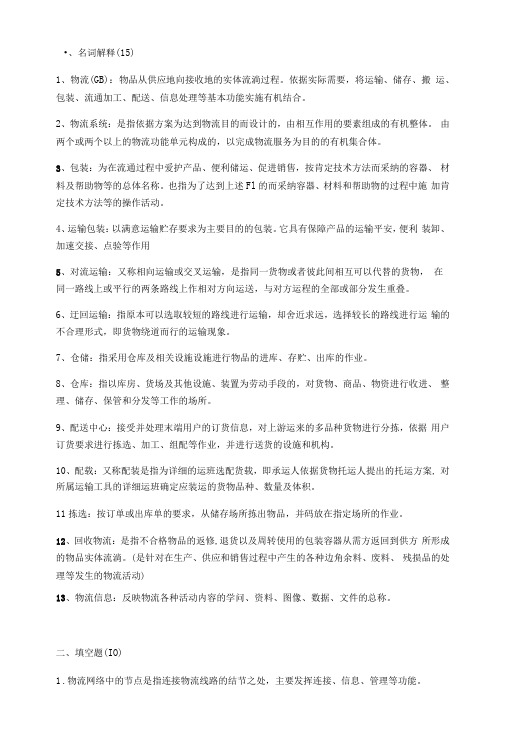
•、名词解释(15)1、物流(GB):物品从供应地向接收地的实体流淌过程。
依据实际需要,将运输、储存、搬运、包装、流通加工、配送、信息处理等基本功能实施有机结合。
2、物流系统:是指依据方案为达到物流目的而设计的,由相互作用的要素组成的有机整体。
由两个或两个以上的物流功能单元构成的,以完成物流服务为目的的有机集合体。
3、包装:为在流通过程中爱护产品、便利储运、促进销售,按肯定技术方法而采纳的容器、材料及帮助物等的总体名称。
也指为了达到上述Fl的而采纳容器、材料和帮助物的过程中施加肯定技术方法等的操作活动。
4、运输包装:以满意运输贮存要求为主要目的的包装。
它具有保障产品的运输平安,便利装卸、加速交接、点验等作用5、对流运输:又称相向运输或交叉运输,是指同一货物或者彼此间相互可以代替的货物,在同一路线上或平行的两条路线上作相对方向运送,与对方运程的全部或部分发生重叠。
6、迂回运输:指原本可以选取较短的路线进行运输,却舍近求远,选择较长的路线进行运输的不合理形式,即货物绕道而行的运输现象。
7、仓储:指采用仓库及相关设施设施进行物品的进库、存贮、出库的作业。
8、仓库:指以库房、货场及其他设施、装置为劳动手段的,对货物、商品、物资进行收进、整理、储存、保管和分发等工作的场所。
9、配送中心:接受并处理末端用户的订货信息,对上游运来的多品种货物进行分拣,依据用户订货要求进行拣选、加工、组配等作业,并进行送货的设施和机构。
10、配载:又称配装是指为详细的运班选配货载,即承运人依据货物托运人提出的托运方案, 对所属运输工具的详细运班确定应装运的货物品种、数量及体积。
11拣选:按订单或出库单的要求,从储存场所拣出物品,并码放在指定场所的作业。
12、回收物流:是指不合格物品的返修,退货以及周转使用的包装容器从需方返回到供方所形成的物品实体流淌。
(是针对在生产、供应和销售过程中产生的各种边角余料、废料、残损品的处理等发生的物流活动)13、物流信息:反映物流各种活动内容的学问、资料、图像、数据、文件的总称。
物流学概论复习题及答案

物流学概论复习题及答案一、选择题1. 物流学中,物流的基本功能包括以下哪项?A. 运输B. 存储C. 包装D. 所有以上选项答案:D2. 以下哪项不是物流管理的目标?A. 降低成本B. 提高效率C. 增加库存D. 提高客户满意度答案:C3. 物流信息系统的主要作用是什么?A. 记录物流活动B. 跟踪货物流动C. 优化物流流程D. 所有以上选项答案:D二、填空题1. 物流是指为了满足客户需求,对货物进行_____________、_____________、_____________、配送以及相关信息处理等一系列活动的总称。
答案:运输、存储、包装2. 第三方物流是指由专业的物流服务提供者,为_____________提供物流服务的模式。
答案:非物流企业三、简答题1. 简述物流的五大基本功能。
答案:物流的五大基本功能包括运输、存储、包装、搬运和信息处理。
运输是将货物从一个地点移动到另一个地点的活动;存储是指货物在一定时间内的存放;包装是保护货物,方便运输和存储的活动;搬运是货物在仓库内部或仓库与运输工具之间的移动;信息处理则涉及物流活动中信息的收集、处理和传递。
2. 描述供应链管理与物流管理的区别。
答案:供应链管理是一个更为宏观的概念,它涵盖了从原材料采购到最终产品交付给消费者的整个流程,包括供应商、制造商、分销商和零售商等多个环节。
而物流管理则更侧重于产品从生产地到消费地的物理流动过程,包括运输、存储、包装等活动。
四、论述题1. 论述现代物流管理的重要性及其对企业竞争力的影响。
答案:现代物流管理对于企业至关重要,它不仅关系到企业成本的控制和利润的最大化,还直接影响到企业的市场响应速度和客户满意度。
高效的物流管理可以降低库存成本,提高资金周转率,加快产品上市速度,提升客户服务水平。
在全球化竞争日益激烈的今天,物流管理已成为企业获取竞争优势的关键因素之一。
五、案例分析题1. 某公司计划建立一个新的物流中心,以提高其供应链效率。
物流学概论考试题库及答案
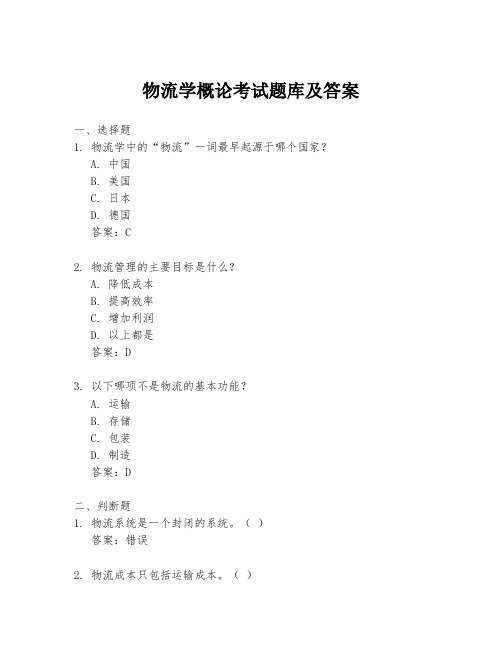
物流学概论考试题库及答案一、选择题1. 物流学中的“物流”一词最早起源于哪个国家?A. 中国B. 美国C. 日本D. 德国答案:C2. 物流管理的主要目标是什么?A. 降低成本B. 提高效率C. 增加利润D. 以上都是答案:D3. 以下哪项不是物流的基本功能?A. 运输B. 存储C. 包装D. 制造答案:D二、判断题1. 物流系统是一个封闭的系统。
()答案:错误2. 物流成本只包括运输成本。
()答案:错误3. 第三方物流是指物流服务提供者与客户之间存在第三方的物流服务模式。
()答案:正确三、简答题1. 简述物流的三个基本要素。
答案:物流的三个基本要素包括:运输、存储和信息处理。
2. 描述供应链管理与传统物流管理的主要区别。
答案:供应链管理强调整个供应链的整合和协同,而传统物流管理更多关注单一企业的物流活动。
四、计算题1. 某物流公司运输一批货物,总重量为5000公斤,运输距离为300公里,每公里运输成本为0.5元。
请计算总运输成本。
答案:总运输成本 = 5000公斤× 300公里× 0.5元/公里 = 750000元。
五、论述题1. 论述现代物流管理的重要性及其对企业运营的影响。
答案:现代物流管理对企业运营至关重要,它通过优化物流流程,降低成本,提高效率,增强客户满意度,从而提升企业竞争力。
六、案例分析题1. 某公司计划建立一个新的物流中心,需要考虑哪些因素?答案:建立新的物流中心需要考虑的因素包括:地理位置、交通便利性、成本效益分析、市场需求、技术设施、环境影响、法规合规性等。
七、综合应用题1. 假设你是一家物流公司的经理,面对当前的市场竞争,你将如何制定物流策略以提高公司的竞争力?答案:作为物流公司的经理,我会制定以下策略:优化运输路线,降低运输成本;采用先进的物流信息技术,提高物流效率;加强供应链管理,与供应商和客户建立紧密的合作关系;注重客户服务,提高客户满意度;持续创新,探索新的物流服务模式。
物流学复习题及参考答案

中南大学现代远程教育课程考试复习题及参考答案物流学一、填空题:1.运输包装通常又称为、等。
2.条形码根据使用目的,可以分为:和。
3.为了区分多余库存,需要对合理库存量做出判断,主要考虑及等因素。
4.运输标志一般由以下三部分组成:、、。
5.包装成本中占比例最大的是,影响包装成本的第二大因素是。
6.配送中心的主要作业活动包括:、、流通加工、、配送、、信息。
7.集装箱货物按托运批量,分为、。
8.物流基础模数尺寸是(单位:mm):。
9.按照标准化工作应用的范围,物流标准可分为、、作业标准。
10.EDI标准包括:、、报文标准、、管理标准、、通信标准、安全保密标准。
11.从包装功能的角度可以将包装分为和。
12.适合于航空运输货物有以下几种类型:、、。
13. 是确定包装尺寸的基础。
14.ECR的四个战略组成包括:、、、。
15.物流概念首先是工商企业的概念。
对于工商企业而言,物流管理的任务通常是:、。
16.现代物流对于服务的要求可以用5R表示(5个合适),它们是:合适的产品、适当的数量、、、合适的地点。
17.通常,工业包装单位的大小决定于和两个主要因素。
18.水运包括和。
19.物流服务的衡量涉及到作业表现。
作业表现体现在从处理订货、入库到交付的全过程中,涉及到和。
20.就物流而言,组织运输工作应该贯彻、、、的基本原则。
21.水路运输具有、、和等特点。
22.货物运输的手段共有五种:铁路、汽车、、航空和等。
23. 是物流各项功能活动中出现频率最高的一项作业活动。
24.运输包装的标志按其用途可分为、和等三种。
二、判断题:1.衡量流通加工可行性,对流通加工环节进行有效管理,可以考虑两类指标:流通加工建设可行性指标和流通加工日常管理指标。
[ ]2.现代物流理念要体现以人为本的思想,促进人类生活和社会福利的提高是现代物流的终极目的。
[ ]3.销售包装有时就是工业包装,比如一些工业产品,或者一些大型的家用产品。
[ ]4.BtoB 电子商务发展最快,已经有多年历史。
物流学原理简答及填空答案

1. What is logistics managementLogistics management is that part of the supply chain management that plans, implements, and controls the efficient, effective forward and reverse flow and storage of goods, services, and related information between the point of origin and the point of consumption in order to meet customer’s requirements.供应链活动的一部分,是为了满足客户需要而对商品、服务以及相关信息从产地到消费地的高效、低成本流动和储存进行的规划、实施与控制的过程。
2. What are the activities included in logistics managementCustomer service, traffic and transportation, warehousing and storage, plant and warehouse site selection, inventory control, order processing, distribution communications, procurement, material handling, parts and service support, salvage and scrap disposal, packaging, return goods handling, demand forecasting.顾客服务、交通与运输、仓储、厂址与仓库地点的选择、库存控制、订单处理、分销信息、采购、物料搬运、提供零部件与维修服务、残值与废物处理、包装、退货处理与需求预测。
- 1、下载文档前请自行甄别文档内容的完整性,平台不提供额外的编辑、内容补充、找答案等附加服务。
- 2、"仅部分预览"的文档,不可在线预览部分如存在完整性等问题,可反馈申请退款(可完整预览的文档不适用该条件!)。
- 3、如文档侵犯您的权益,请联系客服反馈,我们会尽快为您处理(人工客服工作时间:9:00-18:30)。
1. What is logistics managementLogistics management is that part of the supply chain management that plans, implements, and controls the efficient, effective forward and reverse flow and storage of goods, services, and related information between the point of origin and the point of consumption in order to meet customer’s requirements.供应链活动的一部分,是为了满足客户需要而对商品、服务以及相关信息从产地到消费地的高效、低成本流动和储存进行的规划、实施与控制的过程。
2. What are the activities included in logistics managementCustomer service, traffic and transportation, warehousing and storage, plant and warehouse site selection, inventory control, order processing, distribution communications, procurement, material handling, parts and service support, salvage and scrap disposal, packaging, return goods handling, demand forecasting.顾客服务、交通与运输、仓储、厂址与仓库地点的选择、库存控制、订单处理、分销信息、采购、物料搬运、提供零部件与维修服务、残值与废物处理、包装、退货处理与需求预测。
3. What are the challenges of global logisticsSome of the perceived challenges of global logistics are cultural and linguistic differences, duty and custom requirements, just-in-time requirements, logistics support for longer supply chains, finding qualified global suppliers or manufacturers, fluctuations in exchange rates, knowledge of foreign business practices, nationalistic attitude and behavior and understanding the political environment.全球物流的明显挑战在于文化和语言差异、关税要求、适时要求、较长供应链的物流支持、寻找合适的全球供应商或制造商、汇率的波动、国外经营实务知识、国民的态度和行为以及对政治环境的了解。
4. What are the goals of purchasing①Provide an uninterrupted flow of material, supplies and services required to operate the organization.②Keep inventory investment and loss at a minimum.③Maintain adequate quality standards.④Find or develop quality vendors.⑤Standardize the items bought, if possible.⑥Purchase required items and services at the lowest ultimate prices.⑦Maintain the organization’s competitive position.⑧Achieve harmonious, productive working relationships with other departments within the organization.⑨Accomplish the purchasing objectives at the lowest possible level of the administrative costs.①为了保证组织的经营活动不间断地提供物料、供应品及服务②使库存投资与损失降至最低程度③保持适当的质量标准④寻找并开发质量可靠的卖方⑤如有可能,制定出所购项目的标准,使之标准化⑥以最低的最终价格购买所需物料和服务⑦保持组织的竞争地位⑧与组织内其他部门保持协调的工作关系⑨以最可能低的管理成本实现采购目标5. What are the six major product categories①component parts,② raw materials,③ process materials,④ accessory equipment, ⑤major equipment, ⑥operating supplies.部件、原材料、在制品、附属设备、主要设备、经营的供应品6. What are the five basic modes in the transportation systemMotor , rail, air, water, or pipeline.公路、铁路、航空、水路与管道运输7. What are the advantages to the use of containersThe use of containers in intermodal logistics reduces staffing needs, minimizes in-transit damage and pilferage, shortens time in transit because of reduced port turnaround time, and allow the shipper to take advantage of volume shipping rates.货物自托运人运到收货人的过程中,使用集装箱大大减少了劳动力、降低了中转损失、偷窃现象,也由于缩短了船舶在港口的周转时间而缩短了运送时间,货主也从中享有大量货物运费率。
8. How do you understand supply chain managementSupply chain management is the integration of these activities through improved supply chain relationships, to achieve a sustainable competitive advantage. In this definition, the supply chain includes the management of information systems, sourcing and procurement, production scheduling, order processing, inventory management, warehousing, customer service, and after-market disposition of packaging and materials. Supply chains are essentially a series of linked suppliers and customers; every customer is in turn a supplier to the next downstream organization until a finished product reaches the ultimate end user.供应链管理是指为了获得持续的竞争优势,通过改善供应链关系实现供应链活动的一体化。
在本定义中,供应链管理包括:信息系统、寻找原料和采办、生产计划、订单处理、库存管理、仓储和顾客服务。
供应链实质是一系列相互联系的供应商和客户,每个客户又依次是下游组织的供应商,直到最终产品交付给最终用户。
9. What are the benefits of supply chain management①genuine cooperation between all parts of the supply chain②eliminating duplication of effort, information, planning, etc③eliminating operations that do not add value to the customer④improving efficiency and productivity to reduce costs⑤reducing stocks and response times⑥having actual demand trigger replenishments along the chain⑦being more responsive to customers⑧sharing information and links systems⑨using available technology including EPOS, EDI and automated order processing①实现供应链组成部门的真正合作②避免工作、信息和计划的无效性③消除不向顾客提供追加价值的经营活动④提高效率和生产率并降低成本⑤减少库存及其反应时间⑥引发整个供应链的实际需求⑦对顾客作出更好反应⑧分享信息与联系系统⑨使用自动售货点技术(EPOS)、电子数据交换(EDI)等可用技术以及自动订单处理技术。
1. Each element of a firm’s logistics system can affect whether a customer receives the right at the right in the right for the right at the right .2. Packing performs two basic functions: and . In marketing sense the package acts as a form of promotion or .3. The primary objectives of third-party logistics provides are to the total cost of logistics for the supplier and the service level to the consumer.4. Reverse logistics deals with the handling, storage and movement of material that flows from the customer back to the or supplier.5. In any society, industrialized or non-industrialized, goods must be physically moved or transported between the place and the place . The exchange process has become the .6. If a number of individuals or organizations within the society have a surplus of goods that someone else needs, there is a basic for. Channels of distribution develop when many exchanges take place between and .7. Motor carriers are in that they can transport of varying sizes and weights over any distance.8. If a shipper has strict arrival and departure requirement, railroads are at a competitive compared to motor carriers.9. Although increasing numbers of shippers are using air freight for regular service, most view air transport as the premium, service because of its higher cost.10. Air transportation provides rapid but terminal and delivery delays and congestion may appreciably reduce this advantage.11. Not only is the per-unit price lower as a of the discount, but if the company pays the freight, transportation costs will be less on a volume purchase because of transportation economies.12. It also may be necessary to hold an inventory of items that may be in short supply as the of damage in transit, vendor stockout or a strike against one of the company’s suppliers.。
